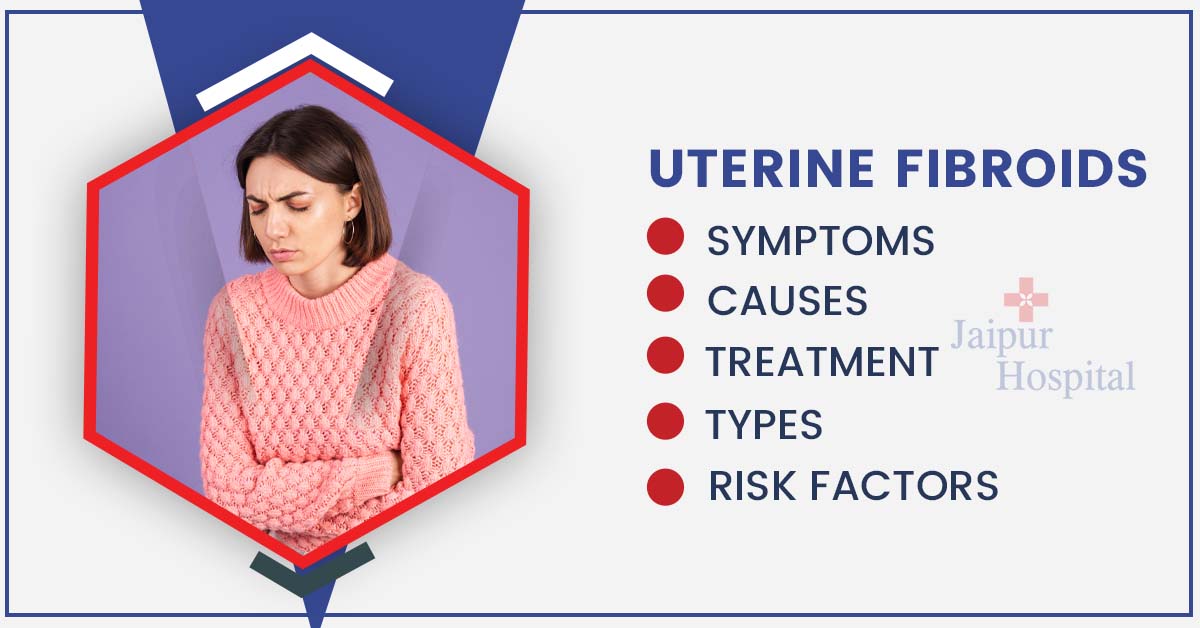What are Uterine fibroids?
Leiomyomas, or uterine fibroids, are growths comprised of the muscle and connective tissue from the uterus’s wall. Typically, these growths are not malignant (benign).Your uterus is an organ with a pear-shaped shape on one side of your pelvis. It is similar in size to a lemon when it comes to the size of your uterus. During pregnancy, it is where a baby develops and grows.
A fibrous tumor may appear as a cluster or as a single nodule (one growth). There are fibroids in a wide variety of sizes, ranging from 1 mm up to 20 cm (8 inches). A watermelon is an example of the size they can reach. These growths may appear on the outside of the uterus, inside its main chamber, or even in its wall. The size, quantity, and placement of fibroids in and on your uterus can all vary.
Fibroids in the uterus can cause a wide range of symptoms and different women will experience different symptoms. Your treatment strategy will be based on your particular circumstance because fibroids can be highly individual.
Types of Uterine Fibroids:
Fibroids come in a variety of varieties. Depending on where they are in or on the uterus, the kinds vary.
- Intramural fibroids: The majority of fibroids are intramural. They manifest themselves within the uterus’s musculature. The expansion of intramural fibroids may cause your uterus to be stretched.
- Subserosal fibroids: Subserosal fibroids develop on the serosa, the exterior of your uterus. They could get big enough to give one side of your uterus the appearance of being larger.
- Pedunculated fibroids: A stem, or thin base, can form in subserosal fibroids, supporting the tumour. They are termed as pedunculated fibroids when this occurs.
- Submucosal fibroids: These tumours grow in the myometrium, the middle layer of uterine muscle. Tumors of the submucosa are less frequent than other forms.
- Cervical fibroids: On the cervix, which joins the uterus and vagina, cervical fibroids form. They’re also uncommon.
Causes of Uterine Fibroids:
Although there are several theories about the origins of uterine fibroid, no definitive cause has yet been identified. The following factors have been identified by clinical experience and research:
- Estrogen: A class of steroid hormones that support the growth and maintenance of the body’s female characteristics
- Progesterone: A hormone that regulates and stimulates a number of bodily processes and helps to keep pregnancies alive.
- Growth hormones, especially transforming growth factors, epidermal growth factors, and insulin-like growth factors
- Genetical factors: A family history of fibroids
- Unwanted cells that exist in the body before birth have the ability to attach to the uterus and grow there.
- Your blood’s micronutrient content: Some micronutrients may be responsible for the growth of fibroids.
- Major stress: Life events that are stressful and possibly childhood abuse
- The majority of medical professionals concur that both estrogen and progesterone play a role in the development of uterine fibroids. They expand rapidly during pregnancy and during times of high hormone levels, and they contract when anti-hormone drugs are taken. After menopause, they can stop growing altogether or decrease.
Symptoms of Uterine Fibroids:
The majority of women with uterine fibroids don’t have any symptoms. The following symptoms are the most typical ones when uterine fibroids do cause them:
- periods that are lengthy or heavy
- period-related bleeding
- backache
- frequent urination
- constipation
- period pain
- painful sex
- pain or pressure in the pelvic area
- having frequent urination (wee) needs
Urinary tract complications are occasionally possible. Even though it is uncommon, large fibroids can prevent a fertilized egg from implanting in the womb or block the fallopian tubes, which can lead to infertility. Pregnant women with fibroids may also experience labor complications and, in rare instances, miscarriage.
The procedure of Uterine fibroids:
Your doctor and you can think about a number of options.
- Fibroid embolization. A fibroid may shrink after embolization. Polyvinyl alcohol (PVA) will be injected by your doctor into the arteries feeding the fibroid. The PVA causes the fibroid to shrink by cutting off its blood supply. In spite of the fact that it isn’t surgery, you might need to stay in the hospital for a few days afterward because the first couple of days following the procedure may be filled with pain, nausea, and vomiting.
- Endometrial ablation. Endometrial ablation is a surgery where doctors remove the uterine lining to lessen the bleeding brought on by tiny fibroids.
- Myomectomy Fibroid removal procedure is called a myomectomy. Your doctor might advise this over other procedures if you intend to get pregnant. Fertility can, however, be impaired by scarring.
It is recommended that you wait four to six months after surgery before attempting to get pregnant. It is common for women to experience symptoms of myomectomy to disappear after the procedure. However, in some people, the fibroids return.
If the surgeon was successful in removing all the fibroids, it will depend on how many you have. In addition to performing abdominal surgery, your doctor may perform a myomectomy or use a hysteroscope or laparoscope to remove the fibroids without needing to make a significant incision on your abdomen. MRI-guided ultrasound radiation can also shrink or destroy fibroids using a more recent technique.
- A hysterectomy. A hysterectomy involves the surgical removal of the uterus. Many women don’t require such extreme treatment. A pregnancy cannot be conceived after this procedure.
Treatment of uterine fibroids:
The majority of fibroid tumors are asymptomatic and do not need to be treated. In actuality, they frequently get smaller or vanish after menopause. But if fibroids are producing bothersome symptoms, there are a number of medical remedies that can be helpful.
Depending on the symptoms, how severe the symptoms are, and where the fibroids are located, a doctor may advise a different course of treatment.
Medication:
Medication is the initial course of treatment for fibroids. Some potential fibroid medications will be covered in more detail in the sections that follow.
GnRH agonists:
The body produces less estrogen and progesterone when taking a medication known as a GnRH agonist. Foloids shrink as a result. Menstrual cycles are stopped by GnRH agonists without having an impact on fertility after treatment is over.
Hot flashes, a propensity to perspire more, vaginal dryness, and, in some cases, a higher risk of osteoporosis are all menopause-like symptoms that can be brought on by GnRH agonists. GnRH agonists should only be used temporarily. These drugs may be prescribed by a doctor to a patient in order to shrink fibroids before surgery.
Nonsteroidal anti-inflammatory drugs:
Ibuprofen is an example of a nonsteroidal anti-inflammatory drug (NSAID) that can lessen fibroid pain but not bleeding.
Hormonal birth control:
Oral contraceptives assist in regulating the ovulation cycle and may lessen the discomfort or bleeding experienced during periods. The use of low-dose hormonal birth control does not cause the growth of fibroids.
The use of progesterone-like injections like Depo-Provera or progesterone intrauterine devices like Mirena is also an option.
Risk factors of Uterine fibroids:
Research indicates that fibroids may shrink following menopause. Fibroids typically increase in size in women of childbearing age. However, research also demonstrates that postmenopausal white women are more likely to experience shrinkage than postmenopausal black women. Fibroid development, growth, and symptom severity are typically earlier in onset, larger, and more severe in African American women.
A woman’s likelihood of developing uterine fibroids may be influenced by a number of factors, such as the following:
- A woman’s age (older women are more at risk than younger women)
- African American race
- Obesity
- Having uterine fibroids runs in the family
- increased blood pressure
- no previous pregnancy
- Vitamin D deficiency
- consumption of food additives
- Use of soybean milk
Fibroid risk-lowering factors include the following:
- Pregnancy (as there are more pregnancies, the risk goes down)
- The use of oral contraceptives and injectable contraceptives for an extended period of time
Diagnose of fibroids:
The diagnostic procedures listed below can aid a physician in identifying fibroids and ruling out other conditions:
- Ultrasound scans: By scanning the abdomen or putting a tiny ultrasound probe into the vagina, a doctor can produce ultrasound images. It could be required to use both techniques to find fibroids.
- MRI scans: Using an MRI, you can count and measure the number of fibroids.
- Hysteroscopy: A hysteroscopy is a procedure where a doctor looks inside the uterus using a small instrument with a camera attached to the end. The uterus will be reached by the instrument through the cervix and the vagina. In order to check for cancer cells, they may also take a tissue sample, known as a biopsy.
- Laparoscopy: A laparoscopy may be carried out by a physician. To inspect the outside of the uterus and the tissues around it, they will make a tiny incision in the abdomen and insert a tiny, illuminated tube. They might also do a biopsy if necessary.
- A person may not be aware that they have fibroids until they undertake a routine pelvic exam because they frequently do not exhibit any symptoms.
Read also: Pregnancy Yoga Stretches


